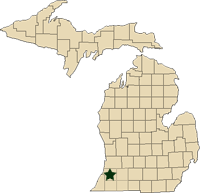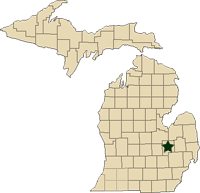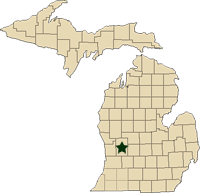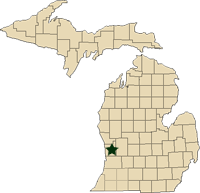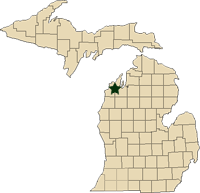Regional reports on Michigan fruit – May 1, 2012
MSU Extension educators’ pest and fruit updates for Michigan.
This week’s regional reports:
- Southwest Michigan - Mark Longstroth, Bill Shane, Diane Brown
- Southeast Michigan - Bob Tritten
- Grand Rapids Area Tree Fruit - Amy Irish Brown and Phil Schwallier
- Grand Rapids Area Small Fruit – Carlos García-Salazar
- Northwest Michigan - Nikki Rothwell, Duke Elsner, Erin Lizotte
Southwest Michigan – Mark Longstroth, Bill Shane, Diane Brown, Michigan State University Extension
|
Weather
Last week was cool with several frosty nights. Highs were near 60 and most lows were around freezing. Plants did not show much growth. Another hard freeze on Friday, April 27 (see Enviro-weather’s report), with lows into the low 20s caused severe damage to tree fruits. This was the fourth severe freeze in April since bloom and each reduced more and more of the crop potential in the southwest. There have also been many less severe freezes this spring. Each freeze has caused a little or a lot more damage. Cool weather has kept plant growth slow and made realistic damage assessments difficult. This coming week's warm weather should make realistic estimates of the cumulative damage possible. Growers should be contacting their crop insurance agents or the local office of the UDSA Farm Service Agency (FSA) to report their loss as soon as possible.
Wednesday (April 25), Saturday (April 28) and Monday (April 30) were wet and rainy. Only Monday’s rain was a widespread infection event for many diseases. Most areas received an inch of rain or more over the week. Soils are wet. Weather for this week is forecast to be much warmer with temperatures similar to those we had in March, with highs in the 80s and lows around 60. There is a chance of rain or thundershowers most of the week. Our growing degree day accumulations are currently only about two weeks ahead of normal for this time of year.
|
Southwest Michigan Growing Degree Day Totals | |||
|
Location |
GDD 42 |
GDD 45 |
GDD 50 |
|
606 |
494 |
333 | |
|
605 |
490 |
329 | |
|
543 |
434 |
365 | |
Tree fruit
All the tree fruits have been damaged by multiple spring freezes this spring and many growers report they no longer have the potential for a commercial crop. Many growers are switching to a minimal spray program focused on disease control to maintain tree health. Growers may want to alter their fertilizer programs if they have no crop. This week’s warm weather should bring out plum curculio with a vengeance and growers may need to protect the fruit they have from egg laying by this pest. Warm weather should also cause good growth and make it relatively easy for growers to assess their remaining crop potential.
Apricots are scarce. Most of the remaining fruit was destroyed in Friday’s (April 27) freeze.
Peach are at shuck split. Fruit is about 8 mm in diameter. There is still a little fruit in the better portions of good peach sites. Some growers report nectarines survived better than peaches. Peach leaf curl symptoms are appearing. It is too late to apply fungicides for this disease. Oriental fruit moth catches continued last week in spite of the cold weather. No flagging of terminal ends by burrowing larvae has been detected. We set biofix as April 13 and treatments may be necessary in the middle of this week.
It is very difficult to know how the various frosts have affected oriental fruit moth egg laying and hatch. Growers should continue oriental fruit moth management in young peach orchards to avoid the disfiguring effects of larvae on limb ends. Tarnished plant bugs adults are present in orchards and are a concern when fruit starts emerging from the shuck. Green peach aphid is present in foliage in some orchards.
Sweet cherry fruit are scarce and about 12 mm in diameter. Some fruit within the canopy of older trees with denser foliage appears to be viable. Growers with fruit should protect against plum curculio. Much more common are fruit with browning flesh freeze damaged flesh and viable seeds. These fruit may persist but they will be unsalable. Most orchards have no fruit. Warm wet weather is forecast this week and protectants for cherry leaf spot are needed.
Most tart cherry fruit are chocolate brown due to the April 27 freeze. Growers should maintain controls for cherry leaf spot to maintain the health of their trees for next year.
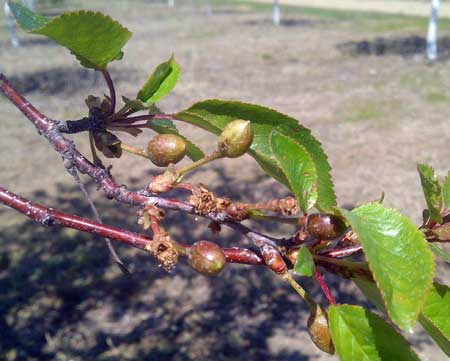
Brown tart cherries. The flesh of these cherries has been frozen.
These will never be plump and juicy, just shriveled and brown.
Plums are scarce. Growers should protect against black knot from this wetting period.
Apples have suffered severe damage from recent freezes. Apple scab symptoms have been found in numerous orchards. These symptoms are probably from a heavy infection period on March 22. Growers should maintain scab coverage in their orchards as spore traps in the area are still catching significant numbers of ascospores. Symptoms of apple mosaic virus, a pathogen spread primarily by propagation, are showing under the cool conditions this spring. Low levels of codling moth males were caught this past week. Growers are looking at lower cost alternatives to scab protection such as copper or lime sulfur in sites with little or no crop.
Pear growers will need to protect against pear scab. Crop loss to frost is widespread. Pear psylla is present, but generally in low numbers
Small fruit
In grapes, new growth is beginning to develop in Concord and Niagara vineyards damaged by widespread freezes on April 6 and April 12. Sites that had survived these earlier freezes were severely injured last Friday (April 27).
The amount of injury sustained by wine grapes varies widely, depending upon site and stage of development. Earlier varieties with more growth were damaged more severely than those still in the bud swell stage. Vineyards with exposed flower clusters need protection against phomopsis as secondary buds develop, and flower clusters develop, fungicides to protect against phomopsis will be needed. Grape berry moth catches were low last week and we have not reached biofix. Some grape flea beetle injury to buds was found, but damage was relatively minor.
Blueberries had generally escaped injury in earlier freezes due to their later development and bloom, but Friday’s freeze caused widespread damage. Fields in some areas showed little damage and others showed severe damage, depended on the lows recorded (which varied from 23 to 27 degrees) and the extent of flower development. Many fields were protected by sprinklers and wind machines and show little damage. Blueberry leaves are red due to cool weather, but they should green up when we get warmer nights this week.
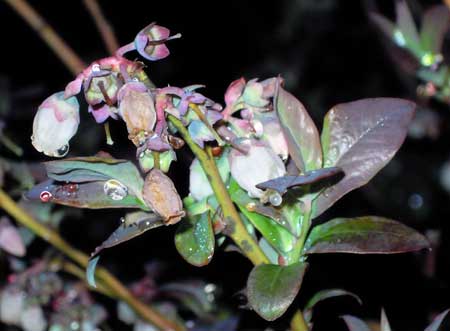
A cluster of blueberry flowers showing healthy flowers and
fruitlets
that were probably killed by the cold. Notice the brown styles on
several of the fruit, indicating freeze injury. If the flower was
pollinated
early enough, they may still set fruit.
Fields with overhead irrigation systems that are running nights for freeze protection are very wet with standing water in the field. Growers with these wet fields from frost protect may want to focus on spring shoot diseases caused by phomopsis and anthracnose, which can cause significant shoot blight under wet conditions.
When good pollinating weather returns, growers should treat for the fruit phase of mummy berry, at 25 percent bloom and full bloom. Scouts have been catching cherry fruitworm and controls may be needed. Cranberry fruitworm traps should be out before bloom. See the Blueberry Insect Scouting Report for April 22-28, 2012 for more information.
Strawberries are blooming and fields are very wet from all the freeze protection this last week. Growers should be checking for angular leaf spot caused by the wet cold conditions.
In brambles, flower clusters are visible in many varieties, and early varieties have begun to bloom. Many plants show leaf scorching from recent freezes. Significant losses in blackberries (dead flower buds) have been reported and some early blooming red raspberries were also affected by the freezes. Damage should be easy to see and assess as we have warm temperatures this week.
Cranberry growers have also been irrigating for freeze protection almost every morning.
Upcoming meetings
A Blueberry Twilight meeting is scheduled for May 2 at True Blue Farms south of Grand Junction. The cost for this meeting will be $10 at the door. Dinner will be provided and will start at 5:30 p.m. After dinner, there will be a review of post bloom insect and disease management in blueberries, irrigation and other topics.
Our next Monday fruit meeting will be May 7 at Fruit Acres Farms at 5 p.m.
A workshop on filtration for small wineries will be held on May 16 from 11 a.m. to 4 p.m. at Karma Vista Vineyards and Winery, 6991 Ryno Rd., Coloma, Mich. (see map and directions). This hands-on review of commercial, small-scale filtration techniques offers perspectives from wine industry suppliers, winemakers and researchers. There will be demonstrations and instruction on plate/frame, DE, membrane technologies, cartridge and crossflow, and bubble-point test. Registration fee, which includes lunch, is $70 for the first person from each winery; $30 for each additional person from each winery. Register online. This meeting is presented by Michigan State University and the Michigan Wine Foundation.
Southeast Michigan – Bob Tritten, Michigan State University Extension
|
Weather
A weekend of more freezing temperatures caused a significant crop loss in all tree fruits across the region. The coldest morning for most fruit growers was Sunday (April 29) with most fruit farms dipping into the lowers 20s, and some even into the high teens. Many of our Enviro-weather stations have had a dozen cold events below 30°F since March 26. We have been losing a percentage of flower buds with each cold event. This last cold snap finished off the rest of the buds.
There were many tree fruit farms that I visited yesterday (April 30) that I could not find any viable fruit. This is the worse freeze damage that we have experienced since 1945, and that year there was still a very small apple crop at a few farms, and we had a good peach crop.
The only bright spots I can find in the last few days are that the severity of this last freeze event was less severe in the southern tier of Michigan counties and that some of our blueberry crop may have survived. The tree fruit crops to the south still have had damage, but not as bad as the rest of east Michigan.
Cool weather has kept our fruit crops in a holding pattern over the last few weeks. Our early, warm season is still running between two to three weeks ahead of normal in terms of growth stages, and even more than that in terms of degree day totals. We are still generally vulnerable to frost and freeze events for the next few weeks, although no cold events are predicted over the next week.
Our soils remain dry for this time of the season, although yesterday’s and last night’s rains have brought between 0.5 and 0.75 inches of much needed rain for most farms. This rain event also delivered an ongoing apple scab infection event. Planting of both tree and small fruits is complete at most farms.
|
East Michigan Growing Degree Day Totals for March 1 to April 30 | |||
|
Location |
GDD42 |
GDD45 |
GDD50 |
|
Commerce (Oakland) |
503 |
397 |
250 |
|
Emmett (St Clair) |
472 |
371 |
234 |
|
Flint (Genesee) |
542 |
433 |
285 |
|
Lapeer (Lapeer) |
535 |
430 |
284 |
|
Petersburg (Monroe) |
574 |
458 |
297 |
|
Pigeon (Huron) |
429 |
332 |
209 |
|
Romeo (Macomb) |
490 |
385 |
240 |
Tree fruits
Apples were mostly at 6 to 8 mm when the freeze event occurred. I believe that with warmer temperatures predicted for later this week that we should be able to better assess the full extent of the freeze damage by the end of the week. Even if a few apples made it through this most recent freeze event, I am still concerned that our pollination weather has been so poor this season. Leaves on apples continue to look sickly. I expect to see heavy fruit drop later this week as well.
Insect pressure seemed to go into another holding pattern in the past week. Growers are asking questions about pest control with little to no apple crop. Read Considerations for commercial apple orchards with reduced crop for more information.
I did get one codling moth adult catch in a trap late last week; I think that he was confused. Oriental fruit moth trap catch dropped back to lower levels last week, with trap catch numbers averaging 15 per trap. I set a regional biofix for oriental fruit moth of April 19. Spotted tentiform leafminer adult trap catch has dropped off as well. I have had no plum curculio sightings. I continue to see a few aphid species, including apple grain aphid, rosy apple aphid and woolly apple aphid. I continue to see a few leafroller larva, including obliquebanded, red banded and fruit tree leafrollers. I am also seeing a few green fruitworm larvae. Predators are being found at increased levels, including green and brown lacewing adults, ladybird beetles, Stethorus beetles and A. fallacis mites.
Most fruit farms have had an apple scab wetting events in the past two days. Yesterday I saw my first apple scab lesions in one orchard that missed an infection period at green tip. We continue to catch apple scab spores at both of our monitoring stations with each wetting event. Growers will need to continue apple scab control until the end of primary apple scab season, even if they have no crop.
Pears were at fruit set when the freeze event took almost all of the fruit at most farms. We have had a significant crop loss in pears. At many farms it is hard to find any viable fruitlets. Pear psylla adults continue to fly, with egg hatch occurring as well.
Peaches are at shuck split. Most peach varieties have had significant fruit loss in the last few days. It is still too early to assess the damage in peaches, but many fruit that appear viable from the outside have internal browning, meaning that the fruit is damaged and will most likely drop early. Some of the fruit that remains on the tree is not swelling in size, which is not a good sign. Oriental fruit moth trap catch was down this last week, and interestingly I have only had trap catch in apples and none in peach blocks. I set a regional biofix for oriental fruit moth of April 19.
Sweet cherries that remained from earlier freeze events have now been damaged by our cold event of Sunday morning (April 29). Most of the fruit is gone at most of our orchards in east Michigan. Cherry leaf spot disease needs to be controlled in blocks that do not have a crop, and maybe cherry fruit fly.
Tart cherries are at early shuck split. Almost half of the bloom was lost to prior freeze damage, and the fruit that remain have an odd off color, indicating to me that it might have been damaged by our last freeze event and most likely will drop early. Cherry leaf spot disease needs to be controlled in blocks that do not have a crop.
Plums were out of the shuck and were severely damaged by the last freeze event. Most blocks have little to no viable fruit remaining.
Small fruits
Strawberriesare at early bloom (only 10 percent bloom) at most farms. Some strawberry farms have frost protected three to four times in the past week. Leaves continue look tough. Strawberry clipper feeding damage was seen at many farms late last week. Angular leaf spot disease symptoms have been seen in low levels at many strawberry farms. Copper applications have been made at most farms for this disease. Growers need to do a thorough scouting for this disease in the next few days.
Raspberry leaves continue to emerge for summer fruiting types and new canes continue to emerge from the soil for fall bearing types. Many of the emerging canes and leaves were badly burned from the freeze events. Fall bearing raspberries will send another crop of canes from the soil in a few weeks.
Blueberries are at 40 percent bloom for a few early varieties, with most varieties being at first bloom. I am seeing a few varieties that have not moved ahead in the past two weeks in terms of flowering stage; it appears that they are sitting still at early pink bud. I have cut many blossoms in these blocks, and can see no visible flower bud damage. Time will tell on these varieties, but I am concerned about this lack of growth. Where frost protection was applied in blueberries, I see little to no damage. Keep an eye out for mummy berry disease and Phomopsis canker in these frost protected blocks.
Grapes were at bud burst when Sunday morning freeze event occurred, with a good number of buds being burned back or damaged from the freeze. There is a good amount of freeze damage in grapes.
Grand Rapids Area Tree Fruit– Amy Irish Brown and Phil Schwallier, Michigan State University Extension
|
Weather information
The overnight temperatures April 27 and again on April 29 have devastated the tree fruit crops on The Ridge and throughout much of west Michigan in general. Temperatures on April 27 were in the low to mid-20s in many areas and frost fans, smudge pots and helicopters weren’t enough this time to fend off the cold. We have spent much time in the past few days cutting buds in various locations and could find very few viable buds in apples and sweet cherries. Peaches are hurt as well, but lesser so at this time. We still need a little time to fully understand what this crop potential is for tree fruit crops on The Ridge.
Growers need to contact their local county UDSA Farm Service Agency (FSA) office to file the appropriate paperwork for any potential disaster funds that might come this way. Growers who have NAP policies with FSA on uninsurable crops need to file a Notice of Loss (form CCC-576) within 15 days of knowing they have a loss. Insured crops (mainly the apples) will be filed through their crop insurance agent and you need to contact them as soon as possible as well. For more information, read “Crop insurance reminders for fruit growers: Don’t wait to make those calls.”
Tree fruit diseases
The rain Sunday night (April 29) into Monday did turn into a scab infection for some locations (Belding and Clarksville, Mich.) and not for others (Fremont, Hart, Kent City, Ludington and Sparta, Mich.). It looked as if it was going to dry off in the late morning, but more rain moved through along a front that ran from the southwest to the northeast to keep the wetting period going. It will not be much fun to have to continue to spray for apple scab for the remainder primary scab season, but you are encouraged to at least get one more good fungicide cover out there this week to protect leaves and maintain the investment you have made so far into this season’s scab control, just in case some fruit does remain. You need to try to continue to keep orchards clean of scab so you don’t end up with a mess to deal with in 2013.
Powdery mildew and fire blight need to continue to be managed as necessary, even with little crop potential. Mildew is already quite prevalent in some blocks and, in order to avoid a big problem in 2013, it needs to be curbed now. Any potential trauma blight conditions also need to be covered for and you can start by applying Apogee. The use of Apogee this year could also help lessen obliquebanded leafroller damage to terminals. Also, by encouraging early terminal bud set, Apogee could reduce potential European red mite issues.
Insects
Insect activity continues to be very slow, but will take a jump with the warm temperatures predicted for this week. For any blocks that might have viable fruit, a petal fall insecticide for plum curculio is advised. There are European red mites present in some blocks and a petal fall miticide would be good insurance to curb this pest so it doesn’t get out of control for next year.
Codling moth will also begin to fly this week and a biofix can then be set from which pesticide timings can made to protect fruit that might still be there. If you have mating disruption up already, you are covered for any possible codling moth for this year.
Grand Rapids Area Small Fruit– Carlos García-Salazar, Michigan State University Extension
|
Climatic conditions in the Grand Rapids, Mich., region continued affecting the conditions of most fruit crops including small fruits such as blueberries, strawberries and raspberries. For the past seven day, maximum daily temperatures were on average 55 and lows averaged 32°F. In addition, light rains have occurred in the entire region with an accumulated precipitation ranging from 0.5 to 1 inch. However, freeze and frost conditions have remained as the main concern for the fruit industry of west Michigan.
On Friday, April 27, we had another spring frost event that lasted from midnight to around mid-morning. Most growers still able to use the sprinkle irrigation for frost protection turned the system on for extended periods of time starting in most places at midnight when low temperatures dropped below the freezing point. In Ottawa County, temperatures below the freezing point lasted on average seven hours with low temperatures dropping in some places down to the low 20s. In the chart below, we can observe the length of the freezing period and average temperatures for different locations in the Grand Rapids, Mich., area.
Length of the period of temperatures
below freezing and average
low temperatures in Michigan’s Grand Rapids region
on April 27
|
Location |
Hours below freezing |
Average temperature °F |
|
7 |
28 | |
|
6 |
29 | |
|
7 |
28 | |
|
7 |
28 | |
|
6 |
28 | |
|
8 |
26 | |
|
8 |
26 | |
|
7 |
27 |
Because of the advanced
developmental stages of most fruit crops, all fruit crops are in bloom or starting
the bloom period; this event has been a serious setback for some growers. For
example, as of April 30, blueberry
crop stages in Ottawa County ranged from 20 to 50 percent bloom in the
varieties Bluecrop and Duke, and 25 percent bloom in Elliott just a little bit
behind those observed in Allegan and Van Buren counties.
A field evaluation conducted in Ottawa County two days after the last freeze and frost event indicated that freeze and frost damage to blueberries goes from 50 percent in unprotected Bluecrop fields to 25 percent in those fields that have been under frost protection. Most affected varieties are Duke and Bluecrop. Even with some frost protection, 90 percent of all open flowers in Duke were affected. However, well-protected Bluecrop fields were unharmed despite 40 to 50 percent of the flowers were opened and damage remained unchanged in relation to the previous evaluation; 17 to 25 percent flower damage.
The daily low temperatures and continued used of irrigation for frost protection is resulting in an increased blueberry disease problems. As a result of the severe frost damage, mummy berry and Phomopsis shoot blight are showing in all fields. Thus, blueberry growers need to continue their disease control program to prevent extensive disease damage. Growers having problems identifying disease problems in their fields, please contact the MSU Extension small fruit program or send tissue samples to MSU Diagnostic Services. For more information contact Carlos García-Salazar at 616-260-0671.
Regarding the other small fruit crops, the conditions are similar to those occurring in blueberries. Strawberries are blooming and frost protection is in progress. Some strawberry growers are expressing concerns about nutrients leaching out due to the intense use of irrigation for frost protection. Therefore, for fields that are using irrigation for frost protection for long periods of time, it is recommended to review fertilization programs to compensate for lost nutrients.
Northwest Michigan – Nikki Rothwell, Duke Elsner, Erin Lizotte, Michigan State University Extension
|
Weather report
Weather during the past week remained cold and we saw daytime temperatures hover in the high 40s and low 50s. Sunday, April 29, was the warmest day of the past week where the daytime temperature hit 64°F. The forecast called for nighttime temperatures into the 20s for Thursday, Friday, and Saturday (April 26-28). Thankfully, we had some cloud cover and warmer temperatures than predicted on Thursday and Friday, but unfortunately, Saturday night cleared off and temperatures dipped into the low 20s across the region. The region also received a little rainfall on Sunday night into Monday (April 30), but accumulations were below a quarter-inch of rain. So far this season we have accumulated 422 GDD base 42 and 210 base 50.
Crop report
Like many other regions of the state, the weather has taken its toll on the fruit crops in the north. Sweet cherries made it through many of the frosts, but were still damaged by the many events we have had this spring; pollination was also an issue in sweet cherries. At the Northwest Michigan Horticultural Research Station (NWMHRS), we have a hard time finding a cherry coming out of the shuck. Tart cherries were hit in March with a wind freeze, and the crop has continued to decline with each freeze event. The apple crop sustained some damage from earlier freezes, but still looked moderately good going into the weekend and the potential was there to set a decent crop. However, the low weekend temperatures hurt the apples as they were beginning to bloom across the region. We do not know the extent of the damage at this time, but those temperatures were a major blow to the apple crop.
Pest report
Cherries. Regardless of the crop load, growers should plan to manage for cherry leaf spot and powdery mildew as green tissue emerges and becomes vulnerable to infection. Cherry leaf spot overwinters in fallen leaves on the orchard floor and produces ascospores (sexual spore) in the spring with dispersal occurring after a wetting event when temperatures are between 60 to 85°F. Despite the recent cool temperatures, the risk to emerging leaf tissue is a concern, particularly as things heat up and rainfall is forecasted to continue this week. When selecting a fungicide for cherry leaf spot protection, keep in mind that cherry leaf spot is resistant to the sterol inhibitor fungicides (Indar, Elite, Orbit) in all the major fruit producing areas of Michigan. Petal fall and shucksplit applications of chlorothalonil are recommended at this point in the season.
Additionally, the Cherry Industry, Michigan State University,EPA, MDARD, and Syngenta have worked together to obtain a 24 (c) special local need registration (SLN) for use of Bravo Weather Stick (chlorothalonil) beyond shuck split. Traditional timing of chlorothalonil for cherry leaf spot has been prohibited past the shuck split timing prior to this newly registered use. With the 24 (c), growers must follow a series of restrictions in order to use this product legally throughout the growing season to ensure that post-shuck split applications do not result in illegal residues. For more information, read “Tart cherries receive 24 (c) for use of Bravo Weather Stik (chlorothalonil) beyond shuck split.”
American plum borer flight came to an abrupt halt this week, likely due to the cool weather and winds last week. Based on historical pest data, peak adult emergence – which is also the recommended timing for trunk applications of Lorsban – has yet to occur. Growers should be looking for obliquebanded leafroller larvae as leaves expand. Overwintering obliquebanded leafroller larvae feed inside bud clusters prior to bloom, and begin feeding on fruit after petal fall. Targeting overwintering larvae is critical because they are small and easier to kill. At early petal fall, growers can scout their orchards by examining 20 clusters per tree in five trees per orchard for larvae or feeding sites. An insecticide should be applied if they observe more than two larvae or feeding sites per tree. The materials that target the larval stage of obliquebanded leafrollers include Delegate, Belt, Altacor, Voliam flexi, Entrust and Bts. Growers in northwest Michigan should not expect organophosphates or pyrethroids to provide effective control because of insecticide resistance. The insect growth regulator Intrepid may also have some level of cross resistance.
Plum curculio activity should start picking up soon with adults migrating into orchards from overwintering sites. Plum curculio migrate from their overwintering sites to orchards in the spring when maximum temperatures are at least 75°F for two to three days or when mean daily temperatures are 55 to 60°F for three to six days. Plum curculio is often found in the orchard before fruit is present. Spring migration lasts about six weeks.
TheMSU Tart Cherry Postponed Insecticide Treatment Strategy (P.I.T.S.) model for plum curculio is estimating the accumulation of just 10 degree days since tart cherry biofix (full bloom 4on April 20 at the NWMHRS), and control is not recommended until 375 GDD from the biofix date leaving plenty of time before treatment. The MSU P.I.T.S. model should only be used in carefully scouted orchards. Most other materials recommend earlier treatment timings that begin around petal fall.
Apples. Despite the rainfall in the last 24 hours (April 30-May 1), temperatures were cold enough that the scab model did not predict an infection period, but trees should remain covered with a protectant scab spray strategy and high risk of economic loss should infection occur. Based on a March 20 biofix (McIntosh green tip), it is estimated that only 26 percent of the primary scab spores have been discharged, but 73 percent are mature. EBDCs tank-mixed with Captan are the recommended protectant scab materials at this time in the season. EBDCs and Captan are both excellent scab protectants, and provide five to six days of protectant activity when used at full rates. Growers should remember that spray intervals should be tighter when relying on these materials. Growers should also keep in mind that strobilurin resistance has been confirmed in all major apple growing regions of the state and the mutation confers complete resistance – strobilurins will not work against apple scab and increasing the rate of a strobilurin is not an effective option. Regardless of crop load, growers should carefully consider their scab management program as inoculum can build quickly over a season and make control difficult in subsequent seasons.
As most orchards are in some stage of bloom, fire blight is a concern and keeping an eye on the weather and the fire blight model remains important. When the epiphytic infection potential (EIP) reaches 100 (or is forecast to do so) and the average temperature is greater than or equal to 60°F, the Enviro-weather model will show the corresponding boxes on the chart turning red, which indicates that if rain or trauma (high winds or hail) occur, there is a high potential for infection. Based on the weather forecast, the EIP is predicted to climb well over 100 this week and may occur in concert with a rain event. At this time, streptomycin remains the bactericide of choice for controlling fire blight in the northwest. However, if you are located in Grand Traverse County and have streptomycin resistance, Kasumin may be applied during bloom. EPA has granted a Section 18 Specific Exemption for the use of Kasumin 2L (kasugamycin) for the control of the blossom blight phase of fire blight in 2012. This use is for orchards where streptomycin-resistant fire blight bacteria are present. The Section 18 is applicable to Berrien, Cass, Grand Traverse, Ionia, Kent, Montcalm, Newaygo, Oceana, Ottawa, and Van Buren counties.
This Section 18 exemption only applies to counties where we have detected streptomycin-resistant isolates of the fire blight pathogen Erwinia amylovora. Read MSU’s George Sundin’s article, “Kasumin has been granted a Section 18 Specific Exemption for fire blight control for 2012,” for more information.
The most important next fire blight control measure is to use Apogee (prohexadione calcium) for shoot blight management. Apogee is a growth inhibitor that provides excellent control of shoot blight. The first timing for an Apogee spray is at king bloom petal fall. Apogee is shoot specific, meaning the effect is only observed if the shoot is covered; thus excellent coverage is essential. The “Apogee effect” on fire blight begins approximately 10 to 14 days after application.
Growers should be on the lookout for obliquebanded leafroller larvae feeding on blossom parts and can begin to gauge the potential for mites by scouting for eggs. Mites overwinter as eggs on rough bark and are most commonly found near buds, fruit spurs, and in the fork of two branches, they can be seen with the naked eye but are very small, so a hand lens is recommended. The red eggs of European red mites are highly visible at this time. Spotted tentiform leafminers continue to emerge in moderate numbers (4-54 per trap).
Grapes. Chardonnay and Riesling are showing signs of bud burst now, but rather unevenly across blocks – even on individual vines there is quite a lot of variability. The predicted temperatures in the 70s will really push things along over the next week.
Bud survival during the past week of freezing evenings appears to have been very good. A sample of Riesling and Chardonnay canes that was collected on April 30 revealed about 18 percent dead buds when dissected under a scope, and several of the dead buds were from old mechanical injury (wire rub, etc.) or at the tips of canes which simply did not lignify and acclimate to cold before the end of the 2011 growing season. Basically, very little damage.
I have not seen any significant feeding injury from grape flea beetles or climbing cutworms to this point, but the warmer days ahead should step up their activity. The next week will be the big opportunity for them to feed on buds, so be on the lookout for them in sites where they have been an issue in the past. If growers have new vineyards with little track record to go on, scout areas nearest to woodlots, where flea beetles can often be found on wild grapes. Cutworms are not so predictable, but there are some references that state they are more numerous in sites with weedy growth under vines.
The window for dormant sprays for powdery mildew control will be ending soon.
Saskatoons.The small test planting at NWMHRS has been stuck in the bloom stage for weeks due to cold temperatures. They are at about 50 percent petal fall now. We have little experience with the pests of saskatoons, but this is the time that we think the sawfly pest of the fruit is active and beginning to lay eggs. If you think you are seeing this insect, I would greatly appreciate hearing about it, and seeing it in person to collect specimens. Contact Duke Elsner at elsner@msu.edu.



 Print
Print Email
Email